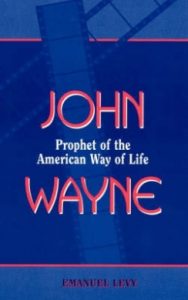Along with his flag-waving war movies, John Wayne made other political features that represented blatant anti-Communist propaganda.
The first and possibly most notable of these was Big Jim McLain, a Wayne-Fellows production released through Warner in 1952.
Perfunctorily directed by Edward Ludwig, the film was written by Richard English, James E. Grant, and Eric Taylor.
Wayne plays a special agent for the House Un-American Activities Committee, who, along with fellow-investigator (James Arness) sets out to investigate the activities of a worldwide Communist ring in Hawaii. The Communists’ assignment is to halt vital shipping to Korea through a work stoppage engineered by a labor leader. An epidemic is also planned by a Communist bacteriologist.
Wayne’s character’s name, Jim McLain, had the same initials of that of Senator Joseph McCarthy, which was seen by many as more than a coincidence, since the star made the picture while he served as president of the Motion Picture Alliance. It is doubtful that other actors, less popular than Wayne, would have agreed to play such a role. It is one of his most propagandistic films of the 1950s, enhancing Wayne image as right-winger and anti-Communist much more than his political statements off screen. Indeed, Wayne believed that Big Jim McLain” helped the election of Senator McCarthy for a second term in 1952.
The screenplay was crude and blatant in its ideological propaganda. The Communists are depicted in the film as a bunch of pseudo-intellectuals and ruthless gangsters engaged in criminal activities, in which immoral party leaders callously sacrifice their fellow-members. Big Jim McLain” also uncritically praised the activities of HUAAC, without questioning its power to jail people for contempt of court, or its damaging effects on the careers of many artists it summoned. And it clearly reflects Wayne’s disgust with the way members of the Communist Party took refuge behind the Fifth Amendment. The movie ends with a question: What can be done with unpatriotic traitors who hide behind the very Constitution they aim to destroy.
Furthermore, the picture implies that the investigations are futile so long as the Communists can use the protection of the Fifth Amendment. At the end of the story, Wayne decides not to quit his work as investigator, despite serious doubts, because it is not in the American and Wayne’s–way to quit a patriotic mission.
Like his other films, Big Jim McLain’s expressed the actor’s “philosophy” of fair play: “I wanted to hit you one punch, just one full-thrown right hand. But now I can’t do it. Because you’re too small. That’s the difference between you and us, I guess. We don’t hit the little guy. We believe in fair play and all that sort of thing.”
To appeal to mass audiences, the producers conceived of “Big Jim McLain” as “a gangster-action” film, but by equating Communism with terrorism, it “could have only reinforced the feelings of the very simple-minded,” as critic Allen Eyles wrote.
Perhaps British critic Alexander Walker said it best when he noted: “As filmmaking, it was unconvincing; as propaganda, it was hysterical. By implication, it gave its nod of approval to informers and offered its pardon to Communists who confessed their errors.”
The movie was much more commercial that most anti-Communist films of the 1950s, grossing close to $3 million in the U.S. alone.
Cast
Big Jim McLain (John Wayne)
Nancy Vallon (Nancy Olson)
Mal Baxter (James Arness)
Sturak (Alan Napier)
Madge (Veda Ann Borg)
Dr. Gelster (Gayne Whitman)
Robert Henreid (Hans Conreid)
Credits:
Released by Warner
Running time: 90 Minutes
Production company: Wayne-Fellows
Produced by Robert Fellows
Directed by Edward Ludwig
Screenplay: James Edward Grant, Richard English, Eric Taylor from a story by English
Camera: Archie Stout











